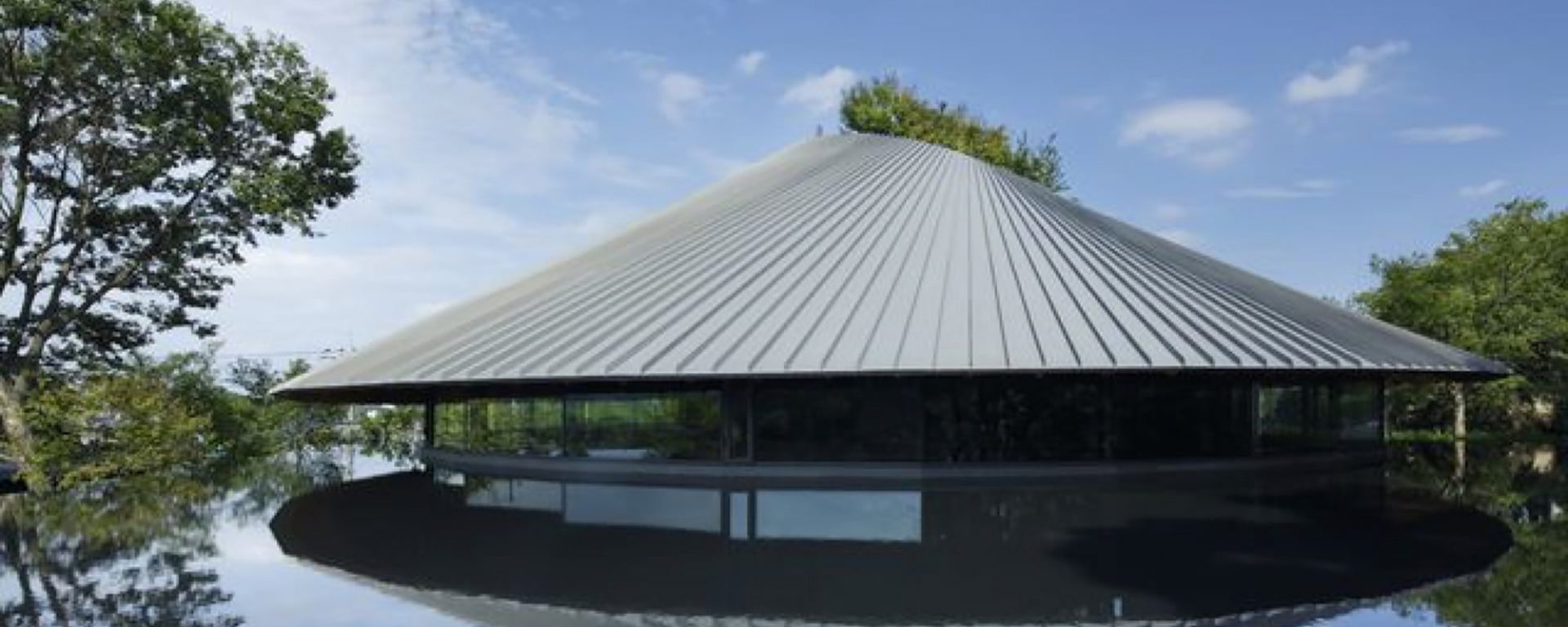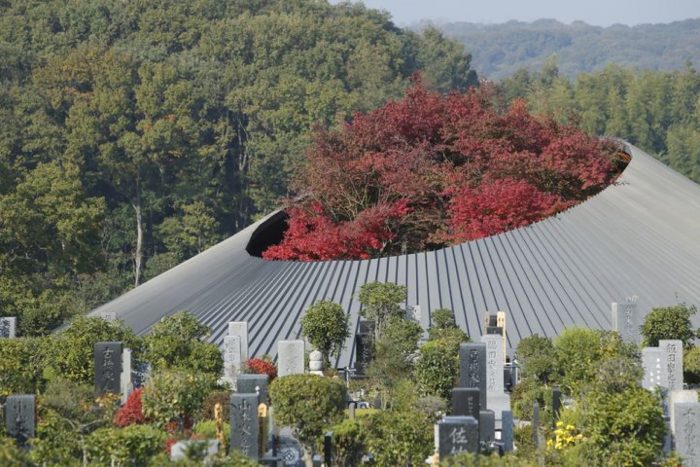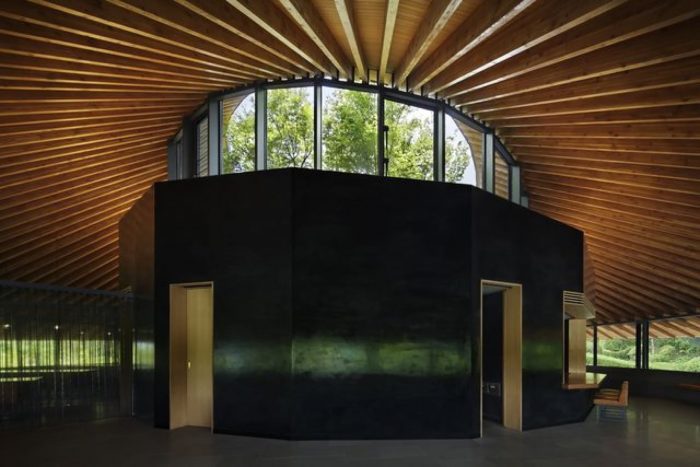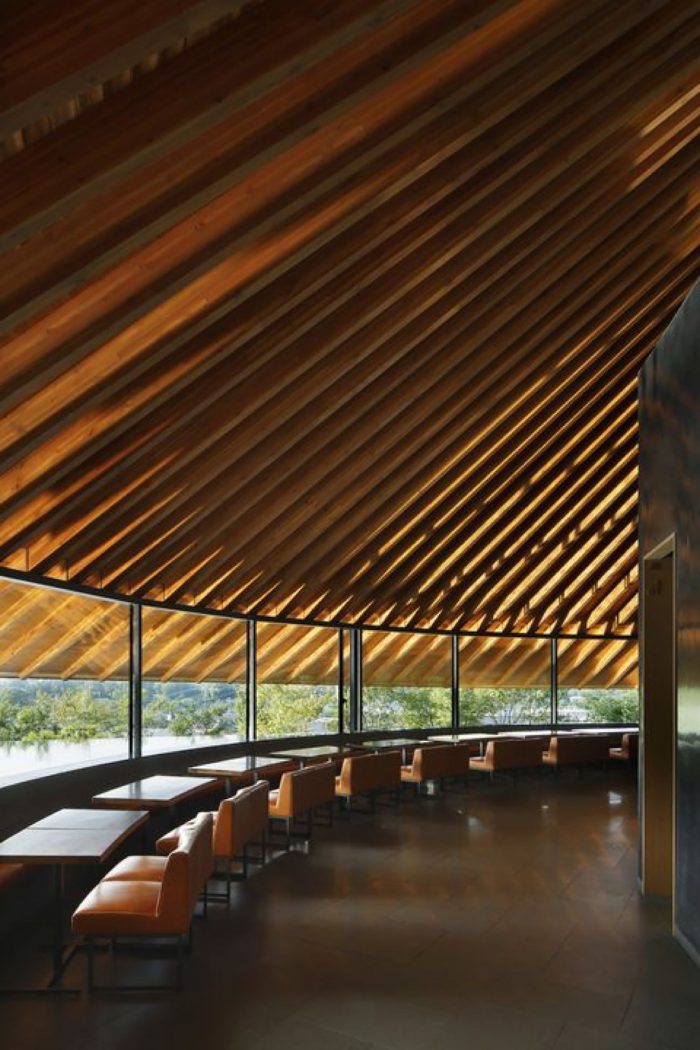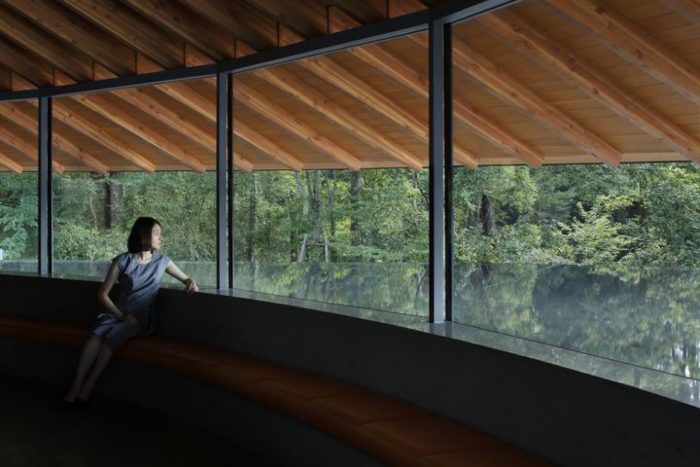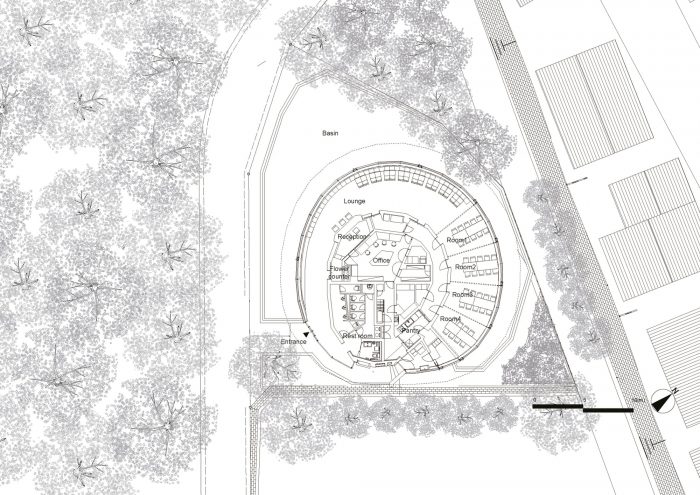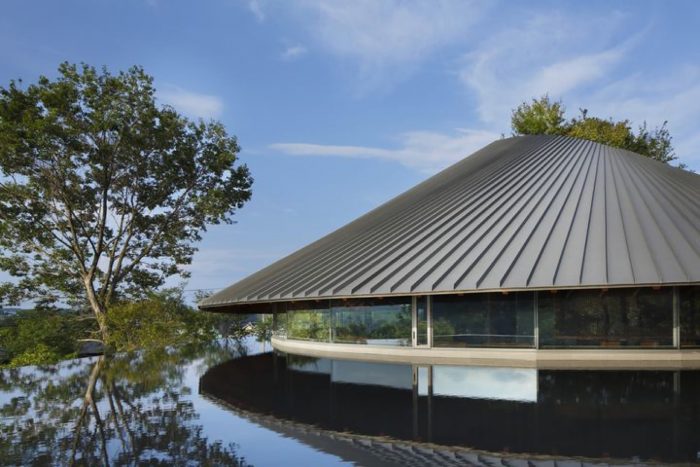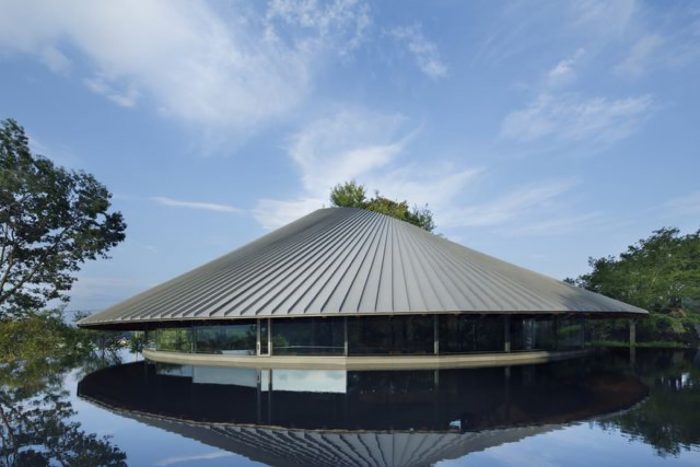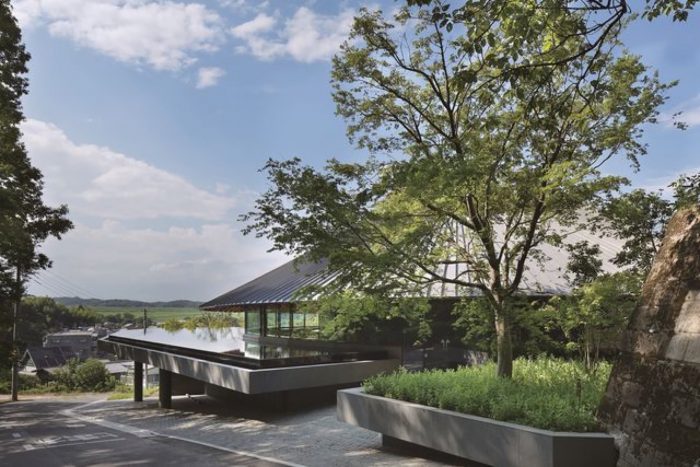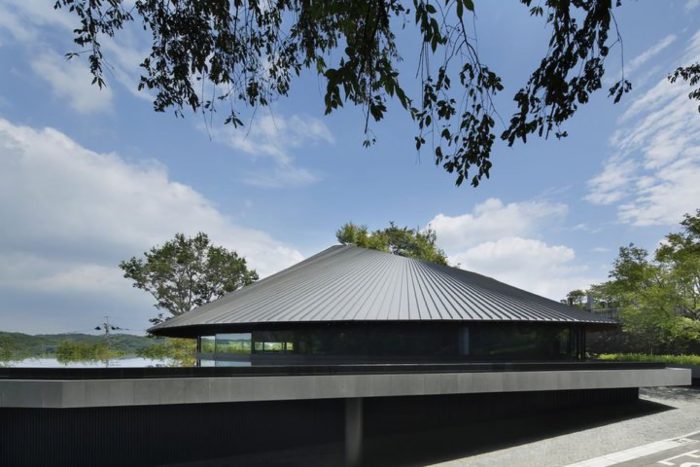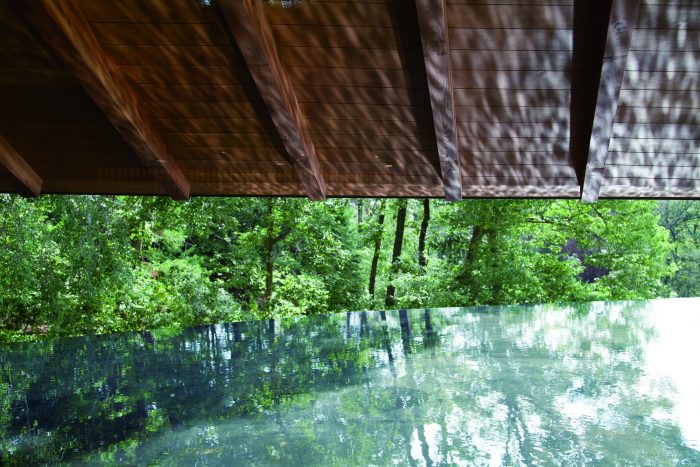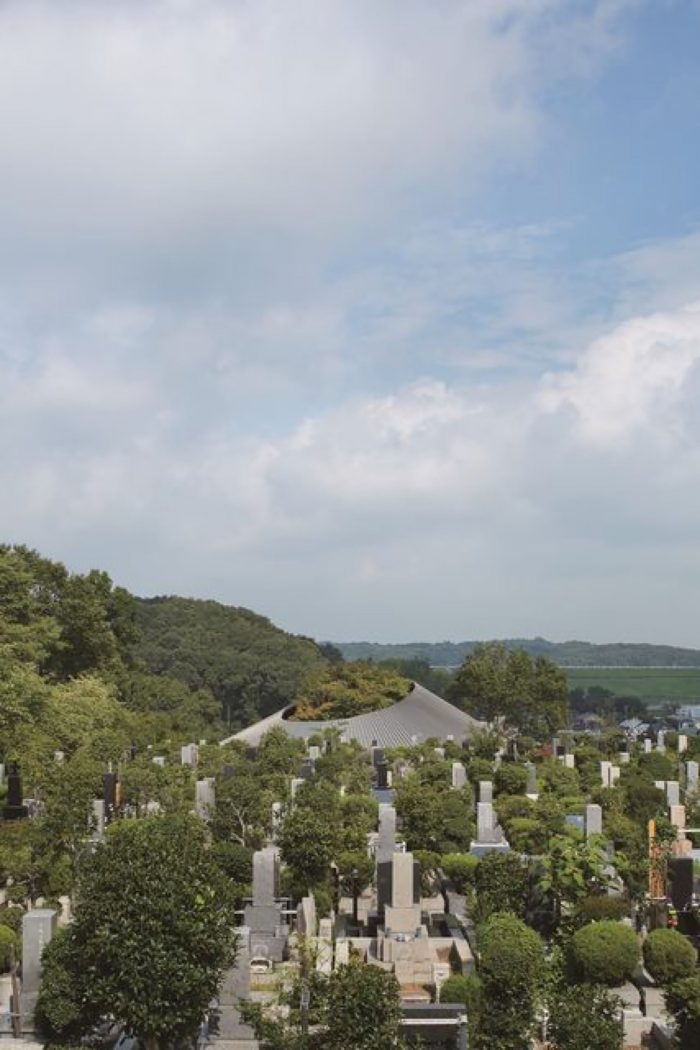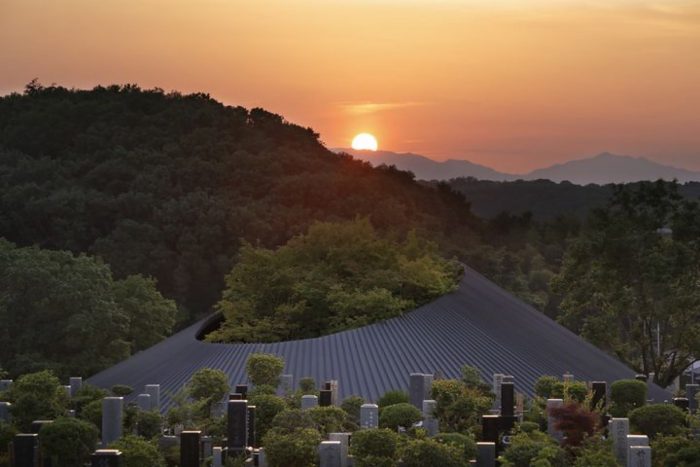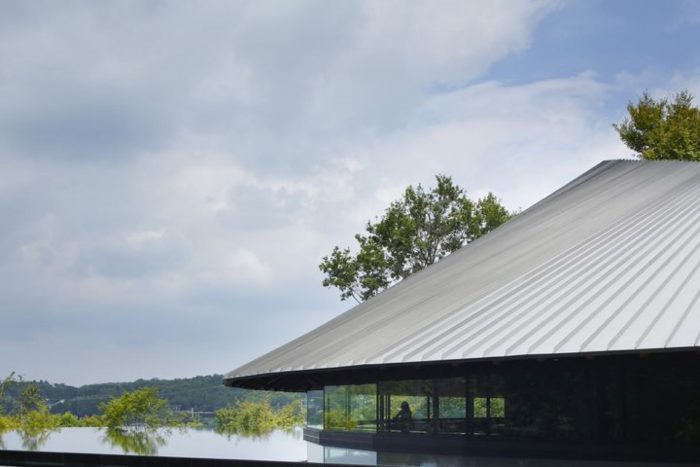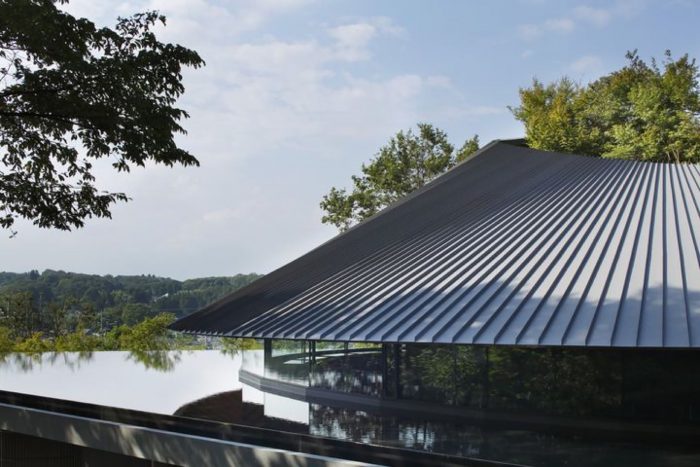这个公墓位于狭山丘陵的茂密森林中。社区大厅矗立在一个城市上方的斜坡上,处于中间位置。这个地方有很好的视野,但我们并不寻求将建筑完全开放给它的风景,也不寻求将它完全关闭。相反,我们想创造一个空间,虽然开放,但有一定程度的封闭性。为此,我们将与服务有关的房间集中在一个中央的钢筋混凝土核心区,并将游客休息室和餐厅安排在核心区周围的一个面向外部的圆形平面上。
This cemetery is located in the lush forests of the Sayama hills. The community hall stands midway on a slope above a city. The site enjoys excellent views, but we sought not to open the building fully to its scenery nor, for that matter, to entirely close it. Rather, we wanted to create a space that, while open, would have a degree of closure. To this end, we gathered the service-related rooms in a central, reinforced-concrete core and arranged the visitor lounge and dining rooms around the core on a circular plan open to the exterior.
在建筑周围有一个静谧的反射池,与附近的狭山湖相呼应,我们将停车场和其他杂项功能安排在视野之外。最后,我们建立了一个由细长、坚固的钢柱和钢梁组成的精致的环形结构,并在上面放置了一个木制的屋顶框架,就像漂浮在空中一样。屋檐高度为1.35米,就像一顶宽边的帽子。
Surrounding the building with a tranquil reflecting pool, resonant with nearby Lake Sayama, we located the parking and other miscellaneous functions out of view. Finally, erecting a delicate ring of slender, solid steel pillars and beams, we placed a wood roof frame, as if floating, above it. The roof, with an eave height of 1.35m, is like a wide brimmed hat.
因此,根据使用者的姿势(坐着或站着),该建筑提供了两种不同的景观视野。对于站着的人来说,这是一个内省的空间,可以间接地凝视自然,在天空和绿色植物在水池中的反射中,以及在水池反射中冲击天花板。巨大的屋顶横梁,下降到外部的游泳池,诱使游客向窗户移动。在那里,窗下的墙壁上有一张皮革软垫的长椅,参观者为了回应天花板的低矮,不自觉地把自己放在长椅上。
As a result, the building offers two different landscape views, depending on the user’s posture (sitting or standing). For people standing, it is an introspective space for gazing on nature indirectly, in the reflections of sky and greenery in the pool, and in the pool reflections striking the ceiling. The large roof beams, descending to the exterior pool, induce visitors to move toward the windows. There, a leather-upholstered bench is built into the wall under the window, and the visitors, in response to the lowness of the ceiling, unconsciously lower themselves onto the bench.
这座建筑因此告诉参观者:”坐下来休息一会儿再走”。在他们坐下的那一刻,狭山的山丘和森林在屋檐下映入眼帘,而城市则出现在远处。在外面,活人的社区与安静的森林形成了对比,死者在那里休息。风吹拂着水池中的绿色倒影。在里面,参观者感到被木梁的温和温暖所笼罩,近得可以触摸。
The building thus tells visitors, “Sit and rest a while before you leave.” The moment they sit, the Sayama hills and forests come into view, under the eaves, and the city appears in the distance. Outside, the community of the living presents a contrast with the quiet forest, where the deceased rest. Winds play on the green reflections in the pool. Inside, visitors feel enveloped in the gentle warmth of wood beams, close enough to touch.
抬起头来,顺着横梁的线条,他们看到了树木遮蔽的阳光之外的天空。当他们沉浸在狭山美丽的自然环境中时,他们想起了逝者。在这个空间里,木头框架总是亲密地靠近,引导人们的行为,或者相反,对它作出反应。办公室上方的屋顶是一个树木的空间,周围有高高的侧窗,让光线和微风进入下面的客人空间。
Lifting their head to follow the lines of the beams, they see the sky beyond tree-filtered sunlight. While absorbed in Sayama`s beautiful natural surroundings, they remember the deceased. In this space, the wood frame is always intimately near, guiding people in their behavior or, to the contrary, responding to it. The rooftop above the office is a space for trees, surrounded by high side windows that allow light and breeze into the guest spaces below.
屋顶上的落叶树作为一个天然的窗帘。夏天,它们长着厚厚的叶子,把明亮的阳光变成柔和的过滤光线。在冬天,它们让温暖的阳光深入到室内。
The rooftop deciduous trees serve as a natural curtain. Growing thick with leaves in summer, they change the bright sun to soft filtered light. In winter, they allow rays of warm sunlight deep into the interior.
环形的窗户略微倾斜,其最高点在接待室和等候室的上方。除了给室内带来节奏感外,窗户的倾斜还具有引导人们进入建筑深处的效果。它还通过自然重力通风实现了被动式空调,冷空气从反射池中被吸入,而暖空气则从窗户的最高点排出。
The ring of windows is slightly inclined, with its highest point above the reception and waiting room. Besides imparting rhythm to the interior, the incline of the windows has an effect of guiding people deeper into the building. It also enables passive air-conditioning by means of natural gravity ventilation, cool air is drawn in from the reflecting pool while warm air is expelled through the windows at their highest point.
Architects: Hiroshi Nakamura & NAP
Area : 483 m²
Year : 2013
Photographs :Koji Fujii / Nacasa and Partners
Contractor : Matsui Kensetsu
Structure Design : Ove Arup & Partners
Textile Coordinate : Yoko Ando
City : Saitama
Country : Japan

